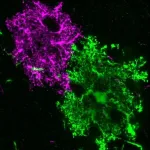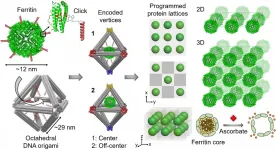(Press-News.org) A near-perfectly preserved ancient human fossil known as the Harbin cranium sits in the Geoscience Museum in Hebei GEO University. The largest of known Homo skulls, scientists now say this skull represents a newly discovered human species named Homo longi or "Dragon Man." Their findings, appearing in three papers publishing June 25 in the journal The Innovation, suggest that the Homo longi lineage may be our closest relatives--and has the potential to reshape our understanding of human evolution.
"The Harbin fossil is one of the most complete human cranial fossils in the world," says author Qiang Ji, a professor of paleontology of Hebei GEO University. "This fossil preserved many morphological details that are critical for understanding the evolution of the Homo genus and the origin of Homo sapiens."
The cranium was reportedly discovered in the 1930s in Harbin City of the Heilongjiang province of China. The massive skull could hold a brain comparable in size to modern humans' but had larger, almost square eye sockets, thick brow ridges, a wide mouth, and oversized teeth. "While it shows typical archaic human features, the Harbin cranium presents a mosaic combination of primitive and derived characters setting itself apart from all the other previously-named Homo species," says Ji, leading to its new species designation of Homo longi.
Scientists believe the cranium came from a male individual, approximately 50 years old, living in a forested, floodplain environment as part of a small community. "Like Homo sapiens, they hunted mammals and birds, and gathered fruits and vegetables, and perhaps even caught fish," remarks author Xijun Ni, a professor of primatology and paleoanthropology at the Chinese Academy of Sciences and Hebei GEO University. Given that the Harbin individual was likely very large in size as well as the location where the skull was found, researchers suggest H. longi may have been adapted for harsh environments, allowing them to disperse throughout Asia.
Using a series of geochemical analyses, Ji, Ni, and their team dated the Harbin fossil to at least 146,000 years, placing it in the Middle Pleistocene, a dynamic era of human species migration. They hypothesize that H. longi and H. sapiens could have encountered each other during this era.
"We see multiple evolutionary lineages of Homo species and populations co-existing in Asia, Africa, and Europe during that time. So, if Homo sapiens indeed got to East Asia that early, they could have a chance to interact with H. longi, and since we don't know when the Harbin group disappeared, there could have been later encounters as well," says author Chris Stringer, a paleoanthropologist at the Nature History Museum in London.
Looking farther back in time, the researchers also find that Homo longi is one of our closest hominin relatives, even more closely related to us than Neanderthals. "It is widely believed that the Neanderthal belongs to an extinct lineage that is the closest relative of our own species. However, our discovery suggests that the new lineage we identified that includes Homo longi is the actual sister group of H. sapiens," says Ni.
Their reconstruction of the human tree of life also suggests that the common ancestor we share with Neanderthals existed even further back in time. "The divergence time between H. sapiens and the Neanderthals may be even deeper in evolutionary history than generally believed, over one million years," says Ni. If true, we likely diverged from Neanderthals roughly 400,000 years earlier than scientists had thought.
The researchers say that findings gathered from the Harbin cranium have the potential to rewrite major elements of human evolution. Their analysis into the life history of Homo longi suggest they were strong, robust humans whose potential interactions with Homo sapiens may have shaped our history in turn. "Altogether, the Harbin cranium provides more evidence for us to understand Homo diversity and evolutionary relationships among these diverse Homo species and populations," says Ni. "We found our long-lost sister lineage."
INFORMATION:
Funding information for this research is available in the respective papers.
The Innovation, Shao et al.: "Geochemical provenancing and direct dating of the Harbin archaic human cranium" https://www.cell.com/the-innovation/fulltext/S2666-6758(21)00056-4 DOI: 10.1016/j.xinn.2021.100131
The Innovation, Ji et al.: "Late Middle Pleistocene Harbin cranium represents a new Homo species" https://www.cell.com/the-innovation/fulltext/S2666-6758(21)00057-6 DOI: 10.1016/j.xinn.2021.100132
The Innovation, Ni et al.: "Massive cranium from Harbin in northeastern China establishes a new Middle Pleistocene human lineage" https://www.cell.com/the-innovation/fulltext/S2666-6758(21)00055-2 DOI: 10.1016/j.xinn.2021.100130
The Innovation (@The_InnovationJ), published by Cell Press in partnership with members of the Youth Innovation Promotion Association (YIPA), a part of the Chinese Academy of Sciences, is a new broad-scope, open access journal publishing basic and applied research that impacts and benefits society. Visit https://www.cell.com/the-innovation. To receive Cell Press media alerts, contact press@cell.com.
WASHINGTON--Antacids improved blood sugar control in people with diabetes but had no effect on reducing the risk of diabetes in the general population, according to a new meta-analysis published in the Endocrine Society's Journal of Clinical Endocrinology & Metabolism.
Type 2 diabetes is a global public health concern affecting almost 10 percent of people worldwide. Doctors may prescribe diet and lifestyle changes, diabetes medications, or insulin to help people with diabetes better manage their blood sugar, but recent data points to common over the counter ...
What The Study Did: This study evaluated changes in hospitalization and death rates related to COVID-19 before and after U.S. states reopened their economies in 2020.
Authors: Pinar Karaca-Mandic, Ph.D., of the Carlson School of Management in Minneapolis, is the corresponding author.
To access the embargoed study: Visit our For The Media website at this link https://media.jamanetwork.com/
(doi:10.1001/jamahealthforum.2021.1262)
Editor's Note: The article includes conflict of interest and funding/support disclosures. Please see the article for additional information, including other authors, author contributions and affiliations, conflict of interest and financial disclosures, and funding and support.
INFORMATION:
Media advisory: The full study ...
What The Study Did: Researchers examined the association of closures of childcare facilities with the employment status of women and men with children in the United States during the COVID-19 pandemic.
Authors: Yevgeniy Feyman, B.A., of the Boston University School of Public Health, is the corresponding author.
To access the embargoed study: Visit our For The Media website at this link https://media.jamanetwork.com/
(doi:10.1001/jamahealthforum.2021.1297)
Editor's Note: The article includes funding/support disclosures. Please see the article for additional information, including other authors, author ...
What The Study Did: This analysis describes the use of a multifaceted COVID-19 control plan to reduce spread of SARS-CoV-2 at a large urban university during the second wave of the pandemic.
Authors: Davidson H. Hamer, M.D., of the Boston University School of Public Health, is the corresponding author.
To access the embargoed study: Visit our For The Media website at this link https://media.jamanetwork.com/
(doi:10.1001/jamanetworkopen.2021.16425)
Editor's Note: The article includes conflict of interest and funding/support disclosures. Please see the article for additional information, including other authors, author contributions and affiliations, conflict of interest and financial disclosures, and funding and ...
What The Study Did: Researchers looked at whether age-related hearing impairment among older adults is associated with poorer and faster decline in physical function and reduced walking endurance.
Authors: Pablo Martinez-Amezcua, M.D., Ph.D., M.H.S., of the Johns Hopkins Bloomberg School of Public Health in Baltimore, is the corresponding author.
To access the embargoed study: Visit our For The Media website at this link https://media.jamanetwork.com/
(doi:10.1001/jamanetworkopen.2021.13742)
Editor's Note: The article includes conflict of interest disclosures. Please see the article for additional information, including other authors, author contributions and affiliations, conflict of interest and financial disclosures, and funding and support.
INFORMATION:
Media ...
Scientists of Tomsk Polytechnic University jointly with their colleagues have synthetized a unique molecule of verdazyl-nitronyl nitroxide triradical. Only several research teams in the world were able to obtain molecules with similar properties. The molecule is stable. It is able to withstand high temperatures and obtains promising magnetic properties. It is a continuation of scientists' work on the search for promising organic magnetic materials. The research findings are published in the Journal of the American Chemical Society (IF: 14.612, Q1).
Magnetoresistive random-access memory (MRAM) is one of the most promising technologies for storage devices. ...
CHAPEL HILL, NC - When we think of the brain, we think of neurons. But much of the brain is made of non-neuronal cells called glial cells, which help regulate brain development and function. For the first, time UNC School of Medicine scientist Katie Baldwin, PhD, and colleagues revealed a central role of the glial protein hepaCAM in building the brain and affecting brain function early in life.
The findings, published in Neuron, have implications for better understanding disorders, such as autism, epilepsy, and schizophrenia, and potentially for creating therapeutics for conditions such as the progressive brain disorder megalencephalic ...
TAMPA, Fla. -- E-cigarettes spark many concerns, especially when it comes to youth vaping. However, emerging evidence suggests that e-cigarettes can be a helpful tool in smoking cessation. Researchers in Moffitt Cancer Center's Tobacco Research and Intervention Program wanted to build upon this evidence by testing whether they could help dual users, people who use both combustible cigarettes and e-cigarettes, quit smoking. In a new article published in The Lancet Public Health, they report results from a first-of-its kind nationwide study evaluating a targeted intervention aimed at transforming dual users' e-cigarettes from a product that might ...
CHAPEL HILL, NC - Developing a viable vaccine against dengue virus has proved difficult because the pathogen is actually four different virus types, or serotypes. Unless a vaccine protects against all four, a vaccine can wind up doing more harm than good.
To help vaccine developers overcome this hurdle, the UNC School of Medicine lab of Aravinda de Silva, PhD, professor in the UNC Department of Microbiology and Immunology, investigated samples from children enrolled in a dengue vaccine trial to identify the specific kinds of antibody responses that correlate with ...
UPTON, NY--Scientists have organized proteins--nature's most versatile building blocks--in desired 2-D and 3-D ordered arrays while maintaining their structural stability and biological activity. They built these designer functional protein arrays by using DNA as a programmable construction material. The team--representing the U.S. Department of Energy's (DOE) Brookhaven National Laboratory, Columbia University, DOE's Lawrence Berkeley National Laboratory, and City University of New York (CUNY)--described their approach in the June 17 issue of Nature Communications.
"For decades, scientists have dreamed about rationally assembling proteins into specific organizations with preserved protein function," ...

